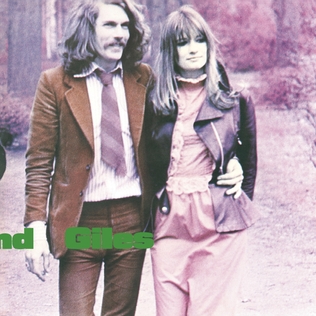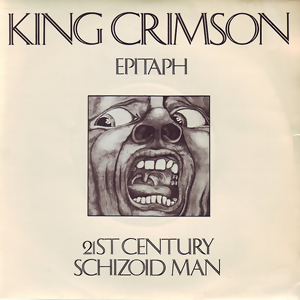
King Crimson were an English progressive rock band formed in 1968 in London. The band drew inspiration from a wide variety of music, incorporating elements of classical, jazz, folk, heavy metal, gamelan, blues, industrial, electronic, experimental music and new wave. They exerted a strong influence on the early 1970s progressive rock movement, including on contemporaries such as Yes and Genesis, and continue to inspire subsequent generations of artists across multiple genres. The band earned a large cult following.

Peter John Sinfield is an English poet and songwriter. He is best known as a co-founder and former lyricist of King Crimson. Their debut album In the Court of the Crimson King is considered one of the first and most influential progressive rock albums ever released.

In the Court of the Crimson King is the debut studio album by English progressive rock band King Crimson, released on 10 October 1969 by Island Records. The album is one of the earliest and most influential of the progressive rock genre, where the band combined the musical influences that rock music was founded upon with elements of jazz, classical, and symphonic music.

Islands is the fourth studio album by English band King Crimson, released in December 1971 on the record label Island. Islands is the only studio album to feature the 1971–1972 touring line-up of Robert Fripp, Mel Collins, Boz Burrell and Ian Wallace. This would be the last album before an entirely new group would record the trilogy of Larks' Tongues in Aspic, Starless and Bible Black and Red between 1973 and 1974. This is also the last album to feature the lyrics of co-founding member Peter Sinfield.

Lizard is the third studio album by British progressive rock band King Crimson, released on 11 December 1970 by Island Records in the UK, and in January 1971 by Atlantic Records in the United States and Canada. It was the second consecutive King Crimson album recorded by transitional line-ups of the group that did not perform live, following In the Wake of Poseidon. This is the only album by the band to feature singer and bass guitarist Gordon Haskell and drummer Andy McCulloch as official members of the band.

Live at Plymouth Guildhall is a live album by the band King Crimson, released through the King Crimson Collectors' Club on the Discipline Global Mobile label in December 2000. The album was recorded at the Guildhall in Plymouth, UK on 11 May 1971.

A Young Person's Guide to King Crimson is a 2-LP compilation album by the band King Crimson, released in 1976. At the time of release, the band had been disbanded. Guitarist Robert Fripp selected the tracks for inclusion.

King Crimson Live at Summit Studios is a live album of radio session recordings by the band King Crimson, released by the Discipline Global Mobile label through the King Crimson Collectors' Club in February 2000. The album was recorded at Summit Studios in Denver, Colorado on 12 March 1972 during one of the band's American tours. The performance was notable for the absence of the band's trademark Mellotron, resulting in an unusual setlist and the inclusion of two lengthy collective improvisations.

Frame by Frame: The Essential King Crimson is a 4-CD box set by the band King Crimson, released in 1991.

McDonald and Giles is an album released by British musicians Ian McDonald and Michael Giles in 1970. The album was first issued on Island Records in the UK and Cotillion Records, a division of Atlantic Records, in the US. The album was recorded at Island Studios between May and July 1970. Although McDonald and Giles remains popular among King Crimson fans, its commercial success was limited. The duo did not record a second album, but Giles did contribute drums and vocals to "Demimonde" on McDonald's solo album Drivers Eyes.
Giles, Giles and Fripp were an English rock group, formed in Bournemouth, Dorset in August 1967. It featured brothers Michael Giles on drums and vocals and Peter Giles on bass guitar and vocals, and Robert Fripp on guitar. The band's music showed an eclectic mix of pop, psychedelic rock, folk, jazz, and classical influences. The group eventually evolved into pioneering progressive rock band King Crimson.
21st Century Schizoid Band were a King Crimson alumnus group formed in 2002.

Gordon Haskell was an English musician and songwriter. A pop, rock, jazz, country and blues vocalist, guitarist, and bassist, he was a school friend of King Crimson guitarist Robert Fripp. The two first worked together in Fripp's mid-1960s teenage group the League of Gentlemen.

Live in Japan is the second "Official Bootleg" release by the 21st Century Schizoid Band. It was released on CD and DVD, the DVD containing the extra tracks "Tomorrow's People" and "If I Was", as well as bonus features.

"Epitaph" is the third track on British progressive rock band King Crimson's 1969 album In the Court of the Crimson King. It was written by Robert Fripp, Ian McDonald, Greg Lake, and Michael Giles with lyrics written by Peter Sinfield.

"The Court of the Crimson King", sometimes billed "In the Court of the Crimson King", is the titular fifth and final track from the British progressive rock band King Crimson's debut album, In the Court of the Crimson King. Released as a single, it reached No. 80 on the Billboard Hot 100 chart, the only King Crimson single to chart on the Hot 100.

The 21st Century Guide to King Crimson – Volume One – 1969–1974 is the first of two 4-CD sets of compilation albums, showcasing the entire production of the British progressive rock band King Crimson. This set of discs contains both studio and live performances ranging from the beginnings of the band in 1969 to their first dissolution in 1974.

The Condensed 21st Century Guide to King Crimson is a compilation by progressive rock band King Crimson, released in 2006. It contains select studio tracks from the two box sets, The 21st Century Guide to King Crimson – Volume One – 1969–1974 and The 21st Century Guide to King Crimson – Volume Two – 1981–2003.

Live at the Orpheum is a live album by the band King Crimson, released by Discipline Global Mobile records in 2015. The album was recorded on 30 September and 1 October at the Orpheum Theatre in Los Angeles, California on the band's The Elements of King Crimson US tour of 2014.

















